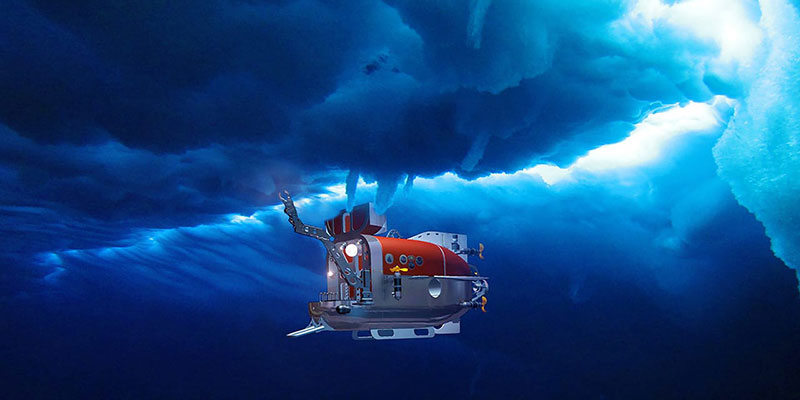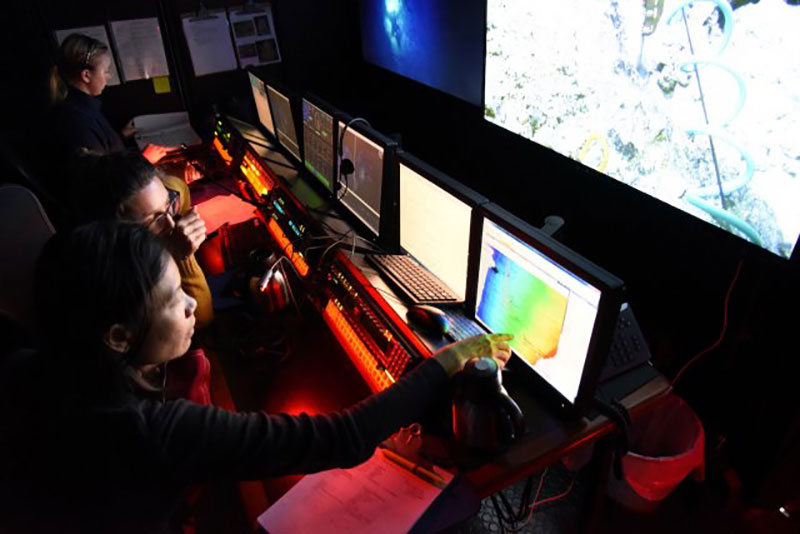Happy World Oceans Day...On Earth and Beyond
June 8, 2019
Happy World Oceans Day! This year, we’re joining partners at the NASA Jet Propulsion Laboratory, NASA Earth Observatory, Ocean Exploration Trust , and Schmidt Ocean Institute in taking a look at the connections between our ocean on Earth as well as oceans elsewhere in our solar system.
Why? While Earth’s ocean and other “ocean worlds” aren’t exactly the same, there are a lot of parallels. And, by joining ocean and space exploration, we can develop better tools and technologies to study Earth and other planets and learn more about our own planet as well as those well beyond, in space.
Earth – Not the Only Planet with an Ocean

This view of Enceladus, one of Saturn's moons, was taken by the Cassini spacecraft in 2016. Over the course of the Cassini mission, observations have shown that under the icy crust of Enceladus is a global ocean, opening the possibility that this moon could support life. Image courtesy of NASA/JPL-Caltech/Space Science Institute.
In looking at images of Earth from space, it's not hard to see why our home is sometimes called "the Blue Planet." Approximately 70 percent of Earth is covered by ocean, and the space between the surface of the ocean and the seafloor is the largest (and least explored) living space on our planet.
But Earth isn't the only ocean world in our solar system. Oceans could exist in various forms on other planets and moons. And as the ocean on Earth is the foundation of life, finding – and exploring – oceans on other worlds could help us find extraterrestrial life.
Extreme Environments...Life Still Finds a Way
This incredible active hydrothermal vent was imaged for the first time during the 2016 Deepwater Exploration of the Marianas expedition on NOAA Ship Okeanos Explorer. It was 30 meters high and gushing high-temperature fluid full of metal particulates. This vent was home to many different species, including Chorocaris shrimp, Munidopsis squat lobsters, Austinograea crabs, limpets, mussels, and snails. Video courtesy of NOAA Office of Ocean Exploration and Research, 2016 Deepwater Exploration of the Marianas.
The deep ocean is one of the harshest ecosystems on Earth, with crushing pressures, darkness, and limited food. Temperatures are generally cold, around 5°C (41°F) at 1,000 meters (3,280 feet) depth, but water temperatures near hydrothermal vents can be as hot as 400°C (752°F)! And yet...life still thrives.
If animals can thrive under these conditions on Earth, what’s to say that they can’t survive in extreme conditions on other planets? As we learn more about ecosystems of the deep Earth ocean, we can uncover clues about where to search for life elsewhere in our solar system.
Putting Technology to the Test
The extreme environments of Earth’s deep ocean can mimic extreme conditions on other planets, making our own ocean a good place to test new technologies for space exploration.
Take Europa, one of the moons of Jupiter. Scientists strongly suspect that a subsurface salty ocean lies beneath Europa’s icy crust. But how do we explore an ocean that is completely under ice? The Arctic Ocean, right here on Earth, is providing the perfect place for scientists to test equipment to do just that. Later this year, a team from Woods Hole Oceanographic Institution and the NASA Jet Propulsion Lab, with support from the NOAA Office of Ocean Exploration and Research and Norwegian partners, will head to the Arctic to use Nereid Under Ice (NUI), a hybrid remotely operated vehicle designed specifically for exploring beneath sea ice, to search for hydrothermal vents first detected in 2014. Continuing development of NUI is facilitating development of under-ice rovers used by NASA to access, and explore, oceans on Europa.
Meteorite Hunting
In March 2018, a bright meteorite fall was observed off the coast of Washington. Later that summer, the Ocean Exploration Trust's Exploration Vessel Nautilus headed out for a meteorite hunt and right now, the Schmidt Ocean Institute's Research Vessel Falkor is off the coast of Washington, continuing the hunt .
Not only could study of any recovered meteorite fragments help unravel the history of our solar system, it could also help us assess hazards from other objects whizzing past Earth in space.
Telepresence to Guide Exploration, On Any World
Thanks to telepresence technology, scientists can actively guide and participate in deep-ocean exploration from shore, without actually being on a ship or on the seafloor. What if we applied the same technology to exploring in space?
A team just completed a mission to test that idea out. Through the SUBSEA (Systematic Underwater Biogeochemical Science and Exploration Analog) Research Program, a partnership between NOAA, NASA, and the Ocean Exploration Trust, scientists are testing how the ocean exploration telepresence paradigm might be adapted to allow interplanetary ocean experts to lead the exploration of oceans on other planets, without having to actually be on another planet.
Preparing for Space Exploration, in the Ocean
This summer, NASA and partners are once again taking to the floor of the Atlantic Ocean to prepare for future deep space missions, including those to the Moon and Mars, with a 10-day NASA Extreme Environment Mission Operations (NEEMO) 23 expedition. NEEMO is a NASA mission that sends astronauts, engineers, and scientists to live and work in the Aquarius Reef Base undersea habitat in the Florida Keys National Marine Sanctuary.
NEEMO 23 will examine the potential challenges of living in an environment similar to space mission conditions and test several emerging technologies, both inside and outside the habitat. It will also enable sponge and coral research, using tools and procedures to simulate geological exploration of the Moon that can be broadly applied to space exploration.




